Everything You Need To Know About Protein Shakes.
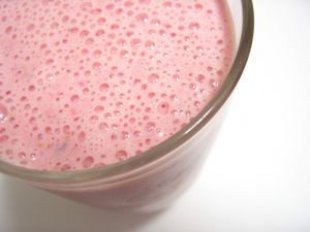
With a little practice and experimentation, you'll soon be making delicious and super-nutritious protein shakes.
Protein supplements are staple item in most nutritional regimens. If you don’t use a protein supplement yet, you probably should start. Why? Protein is such an important nutrient for overall health that it’d be hard to overstate just how important it is. You need protein on a continual basis. You need protein to manufacture new immune cells and compounds to replace those destroyed in the line of duty. You need protein to replace old and defective blood cells on a constant basis. You need protein to grow healthy hair, skin and nails. You need protein to make enzymes to digest food and detoxify your body. Protein – and not minerals like calcium- is what gives bones their tensile strength (the ability to withstand impacts and mechanical stress without breaking). Muscular strength, growth, repair and maintenance all require protein too.
How much protein do you need?
That’s proved to be a very difficult question to answer. Protein requirements fluctuate widely according to many different factors; age, activity level, physical status and medical conditions.
A good ballpark figure for healthy people is 1 gram of protein per pound of ideal body weight per day. Some people, such as bodybuilders, athletes or those recovering from illness or injury may need even more. Some people may need less.
As important as protein is, it’s both difficult and impractical to try and get optimal amounts of protein from high-protein foods alone. Those protein-rich foods – like meats, dairy, seafoods and eggs – may supply lots of protein, but other considerations limit how much and how often you can eat them. These foods are expensive, perishable, and the protein you want is accompanied by things you may not want any more of, such as saturated fat and cholesterol. Not only that, but none of these are really stand-alone foods. A grilled chicken breast makes for a lonely lunch.
But a protein shake needs nothing else to accompany it. It’s a stand-alone food that gives you plenty of protein, but very little else. That’s one of the great things about them: you can control what other nutrients go into the shake.
Making the protein shake itself is a simple process; you mix the powder into some liquid, blend or stir it up, and it’s ready to drink. But when you use protein shakes day in and day out, the same old products and recipes can get boring. So we’ve put together this information to help you make the best-tasting, most-nutritious and least-boring protein shakes possible.
Amounts: Most people don’t measure shake ingredients precisely preferring to just use approximate measurements. One good way to ensure you don’t make too much or too little; put all the ingredients into your glass first, leaving about 1/4 empty, then pour them all into the blender.
Protein powders: Protein powders have come a long, long way from the chalky hard-to-mix products of the past. New flavoring ingredients, sweeteners and manufacturing processes have made them easier-to-mix and better-tasting than ever before. Whey protein powders are the most popular type. Whey is the fastest and most easily absorbed type of protein and tastes great. A good dairy-free alternative to whey protein would be egg white protein. If you’re vegetarian or vegan, soy protein powders are the most popular choice. Meal replacement powders are used just like protein powders, but supply extra nutrients like vitamins, minerals and carbs to make them more nutritionally complete. There are hundreds of varieties available. Two very popular choices are the Optimum Nutrition 100% Whey Gold Standard and BSN’s Syntha-6. Most people experiment or rotate through a few brands in the course of finding their favorite type and flavor.
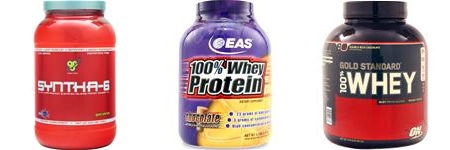
Whey proteins are the most popular choice, but not the only choice.
Liquids: Cold liquids always taste best. Very few protein powders are intended to be used in warm or hot beverages, although some people use chocolate whey protein to make hot cocoa. The best liquids are cold pure water, cold milk, and/or diluted fruit juice. You’ll want to dilute fruit juice because protein powders usually have plenty of sweetener already in the formula. Avoid using acidic fruit juices like orange, lemon, grapefruit and cranberry except in small amounts; the acids can denature the protein powder, forming unappetizing clumps that don’t dissolve easily. Do not use carbonated or alcoholic liquids in a protein shake.
Ice: Adding some ice makes a big difference in drink-ability by keeping the shake cold for a longer time and also by diluting the mixture slightly. You can also make flavored “ice” cubes by using diluted fruit juice such as apple, grape or fruit punch, or even chocolate milk. Use those in a shake for more flavor and variety.
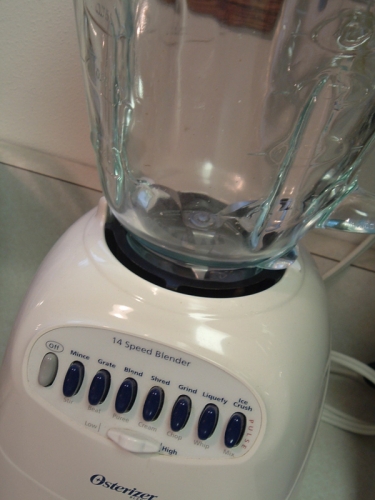
Blenders work best for making protein shakes
Mixing: By far, electric blenders work best because they have the power to break down frozen ingredients completely and mix them up in the most uniform way. Handheld mixers are the next best approach. Many protein powders are “instantized” meaning the particle size has been reduced so they mix up much easer. These would be the kind of protein to use in a shaker cup or if you’re just using the spoon-and-glass-approach.
Enhancements: Besides the protein powder itself, there are dozens of other ingredients that can be added to your protein shake to enhance the taste and/or nutritional profile.
Greens: Greens supplement powders sure don’t do much for the visual appeal of a protein shake, but they add nutritional appeal. Greens supplements are a good source of the same kinds of nutrients found in the proverbial dark green leafy vegetables that no one eats enough of. Greens powders do have a strong characteristic taste, though, so they only blend well with a few other ingredients. Diluted apple juice or white grape juice both work very well.
Lecithin granules: Add healthy fats to your shake; lecithin is especially good for the brain and cardiovscular system. Lecithin is essentially tasteless and very inexpensive.
Effervescent Vitamin C: Both NOW Foods and Alacer make terrific vitamin C products in effervescent drink-mix form. They come in a variety of flavors and add interesting new tastes as well as vitamin C and other vitamins to your protein shake.
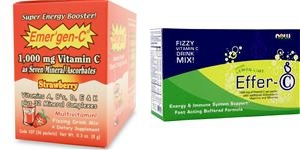
Effervescent Vitamin C packets are a great shake enhancement
Cocoa powder: Unsweetened cocoa powder is a great way to add some antioxidants and a more intense chocolate flavor to protein shakes.
Cinnamon: Cinnamon really wakes up the flavor of bland vanilla protein powders as does a dash of vanilla extract.
Frozen fruit: Most fresh or frozen fruits work great in a protein shake. Frozen mixed berries work well. Peeled and sliced ripe bananas are good with certain flavors also. Watch the amounts though, as too much fruit -especially the pectin-rich fruits like blueberries and strawberries – will make the shake too thick and gelatinous to enjoy. Fruits with edible peels like grapes and apples don’t work well.
Carbs: Protein powders have very low carbs, which most users appreciate. But many types of athletes and other users will want to add extra carbs to their protein shake to enhance recovery or weight gain. Carb powders are the best way to do this, since they are inexpensive and transparent in taste.
Carnitine: Carnitine is a natural energy-factor for all muscle in the body, especially the heart muscle. But it’s not a stimulant and is very safe for most people. In liquid form, it has a very agreeable taste and is very easy to add to a protein shake.

Liquid carnitine, an energy factor for muscles, is another great shake enhancement.
Creatine: Creatine is tasteless and very easy to ‘hide’ in a protein shake. Creatine benefits muscle tissue and more.
Glutamine: Glutamine is a multi-purpose ‘supernutrient’ that supports a very long list of bodily structures and functions. Like creatine, it’s tasteless and easy to include in a protein shake.
Multivitamin powder: There are excellent multivitamin-mineral supplements in powder form, these can be used to boost the vitamin and mineral content of a shake.
Nuts: You can add small amounts of healthy nuts like raw almonds or walnuts to your protein shake. They add healthy fats, vitamins and fiber.
Probiotic powders: Entire books have been written on the benefits of these friendly bacteria for immune and digestive health. Probiotic powders are easy to add into protein shakes and have only a minimal effect on taste.
Flaxseed oil: Liquid flax seed oil can be added to protein shakes to supply valuable omega-3 fatty acids. Flax oil has a nutty taste, not unpleasant, but you’ll want to start with small amounts, increasing it as you become accustomed to it.
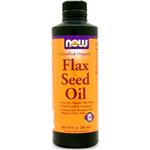
Use flax seed oil to add healthy omega-3 fats to your shake.
One of the things you can’t do easily with a protein shake is store it. It’s nearly impossible to keep all the ingredients mixed together; they tend to settle out in a short time. While you could re-mix them at that point, we’ve found that the results leave a lot to be desired. You’re much better off mixing them up when you have the time to drink them immediately thereafter. If you need a portable option, what you want is a ready-to-drink protein shake.
Recipe Ideas and Combinations:
Vanilla protein goes well with; water, fruit juice, milk, cinnamon, splash of orange juice, any flavor of effervescent vitamin C, frozen fruit, almonds, walnuts, raisins, cocoa powder. A small amount of lime or lemon juice makes some types of vanilla protein taste like key lime or lemon meringue pie.
Chocolate protein goes well with: water or milk (not fruit juice), splash of chilled coffee, almonds, walnuts, peanuts, shredded coconut, bananas, raisins, cocoa powder.
Berry flavored protein goes well with: frozen fruit, diluted fruit juice, any flavor of effervescent vitamin C, shredded coconut, dash of lemon juice.
- Posted in Miscellaneous
- No Comments



